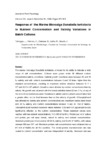Mostrar o rexistro simple do ítem
Response of the Marine Microalga Dunaliella tertiolecta to Nutrient Concentration and Salinity Variations in Batch Cultures
| dc.contributor.author | Fábregas, Jaime | |
| dc.contributor.author | Herrero, Concepción | |
| dc.contributor.author | Cabezas, Buenaventura | |
| dc.contributor.author | Liaño, Rosa | |
| dc.contributor.author | Abalde, Julio | |
| dc.date.accessioned | 2015-09-09T16:09:16Z | |
| dc.date.available | 2015-09-09T16:09:16Z | |
| dc.date.issued | 1986 | |
| dc.identifier.citation | Fabregas J, Herrero C, Cabezas B, Liaño R, Abalde J. Response of the marine microalga dunaliella tertiolecta to nutrient concentration and salinity variations in batch cultures. J Plant Physiol 1986;125(5):475-84. http://dx.doi.org/10.1016/s0176-1617(86)80010-4 | es_ES |
| dc.identifier.issn | 0176-1617 | |
| dc.identifier.uri | http://hdl.handle.net/2183/14914 | |
| dc.description.abstract | The marine microalga Dunaliella tertiolecta is known for its ability to tolerate a wide range of salt concentrations. Cultures were grown under 56 different nutrient concentration-salinity conditions. Optimal growth conditions were between 25 and 35 ‰ salinity and with nutrient concentrations between 8 and 32 times higher than the standard concentrations, resulting in maximum cellular densities between 8.41 x 106 and 16.74x 106 cells/ml. Growth is more affected by nutrient concentration than by salinity. No growth was obtained with the lowest salinities tested (0 and 5 ‰) at any of the nutrient concentrations used. Variations in salinity and in nutrient concentration had a greater effect on the final biomass than on the velocity of growth. Chlorophyll-a/ml was affected by salinity and nutrient concentrations and maximum values were found with 30 ‰ salinity and nutrient concentrations between 8 and 64 mM of NaNO3. Chlorophyll-a/cell reached maximum values between 2.02 and 3.51 pg/cell and is only significantly affected by the nutrient concentration. These maximum values were reached with low nutrient concentrations (1-2 mM of NaNO3). Protein per ml of culture and protein per cell were closely related to salinity and nutrient concentrations. Maximum protein per ml occurred at 20-25 ‰ salinity and 64mM of NaNO3, with values between 926 and 957 μml. Maximum protein/ cell concentrations were obtained also at 64 mM of NaNO3 for all the salinities. The nitrate-protein transformation rate was related to nutrient concentration and was independent of salinity. Maximum rate was 100% at 20 ‰ salinity and 1 mM of NaNO3. This rate decreased as nutrient concentrations increased. | es_ES |
| dc.language.iso | eng | es_ES |
| dc.publisher | Gustav Fisher Verlag | es_ES |
| dc.relation.uri | http://dx.doi.org/10.1016/s0176-1617(86)80010-4 | es_ES |
| dc.subject | Chlorophyll a | es_ES |
| dc.subject | Protein | es_ES |
| dc.subject | Dunaliella | es_ES |
| dc.subject | Microalga | es_ES |
| dc.subject | Nutrients | es_ES |
| dc.subject | Salinity | es_ES |
| dc.title | Response of the Marine Microalga Dunaliella tertiolecta to Nutrient Concentration and Salinity Variations in Batch Cultures | es_ES |
| dc.type | info:eu-repo/semantics/article | es_ES |
| dc.rights.access | info:eu-repo/semantics/openAccess | es_ES |






